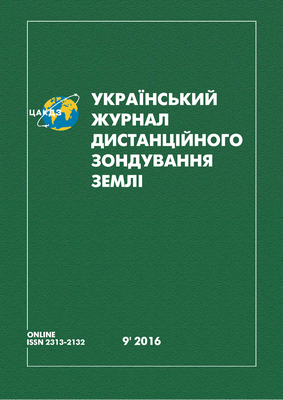Евристичні методи оцінки ділянок нафтогазоперспективних територій на основі міждисциплінарної інтеграції аерокосмічної і наземної інформації (на прикладі Дніпровсько-Донецької западини] {
DOI:
https://doi.org/10.36023/ujrs.2016.9.75Ключові слова:
нафтогазоперспективність, генетичні алгоритми, аналітичні мережі, лінеаменти, тектонічний розлом, неотектонічні блоки, морфометричні дослідження, труктурне дешифрування, фотометрування, оптична аномаліяАнотація
На основі генетичного алгоритму, аналітичних мереж та міждисциплінарної інтеграції аерокосмічної і наземної інформації різної фізичної природи і даних різної розмірності виконано оцінку нафтогазоперспективності ділянок Турутинсько-Рогінцівської зони структур Дніпровсько-Донецької западини для наступних нафтогазопошукових робіт.
Посилання
Arkhipova T. O., Tovstyuk Z.M., Kozlova Z.V., Fedorovsky O.D., Yakimchuk V.G. (2006). Assessment of the oil and gas prospects of the territory based on the use of a systematic approach and space information for advanced geophysical exploration. Geoinformatics, 3, 40–45.
Fang H. L. Genetic algorithms in timetabling and scheduling. A dissertation. Department of Artifical Intelligence University of Edinburg, Edinburg. 2000. – 153 p.
Fedorovsky A.D., Artyushenko M.V., Kozlov Z.V. (2004). Parametric synthesis of space systems for sensing the Earth based on the genetic method. Space science and technology. T.10, 1, 54–60.
Fedorovsky A.D., Ryabokonenko S.A., Kozlov Z.V. (2003). Basic requirements for the parameters of the space equipment complex for sensing the Earth. Additional information from NASU. 7, 118-122.
Goldberg David E. Genetic Algorithms in Search, Optimization and Machine Learning. USA: Addison – Wesley Publishing Company, Inc. 1989. –315 р.
Ivanyuta M.M., Fedyshyn V.O. and others (Eds.) (1998). Atlas of oil and gas deposits of Ukraine. Lviv, UNGA, T.1, Eastern oil and gas district.
Kozubtsov I. N. Interdisciplinary field of knowledge - as a new scientific specialty. The future of technical science: collection of materials XI International. youth scientific-technical conf.; NSTU im. R.E. Alekseeva. – Nizhny Novgorod: 2012, 409 – 410.
Norenkov I.P. (1998). Genetic methods for structural synthesis of design solutions. Information Technology. 1, 9–13.
Saaty, T. (1993). Making decisions. Hierarchy analysis method. Moscow, Radio and communications.
Saaty T. (2009). Decision making under dependencies and feedbacks: analytical networks. Moscow, Book House "LIBROKOM".
The phenomenon of paragenesis of subvertical zonal-ring-shaped geophysical, geochemical and biogeochemical fields in the sedimentary cover. AAPG Bull. –1979. – Vol. 6, N 2. –. P.236-254.
##submission.downloads##
Опубліковано
Як цитувати
Номер
Розділ
Ліцензія
Ліцензійні умови: автори зберігають авторські права та надають журналу право першої публікації на твір, одночасно ліцензований за міжнародною ліцензією Creative Commons Attribution License International CC-BY, що дозволяє іншим поділитися твором з підтвердженням авторства твору та первинною публікацією в цьому журналі.
Автори, направляючи рукопис у редакцію «Українського журналу дистанційного зондування Землі», погоджуються з тим, що редакції передаються права на захист і використання рукопису (переданого до редакції журналу матеріалу, в т. ч. такі об’єкти авторського права як фотографії автора, рисунки, схеми, таблиці тощо), в тому числі на відтворення у пресі та мережі Інтернет, на поширення, на переклад рукопису на будь-які мови, експорту та імпорту примірників журналу зі статтею авторів з метою розповсюдження, на доведення до загального відома. Зазначені вище права автори передають редакції без обмеження терміну і на території всіх країн світу без обмеження в т. ч. на території України.
Автори гарантують наявність у них виняткових прав на використання переданого редакції матеріалу. Редакція не несе відповідальності перед третіми особами за порушення даних авторами гарантій. За Авторами залишається право використання їх опублікованого матеріалу, його фрагментів і частин в особистих, у тому числи наукових і освітянських цілях. Права на рукопис вважаються переданими Авторами редакції з моменту підписання до друку випуску журналу, в якому він публікується. Передрук матеріалів, опублікованих у журналі, іншими фізичними та юридичними особами можливий тільки зі згоди редакції, з обов’язковим зазначенням випуску журналу, в якому було опубліковано матеріал.
